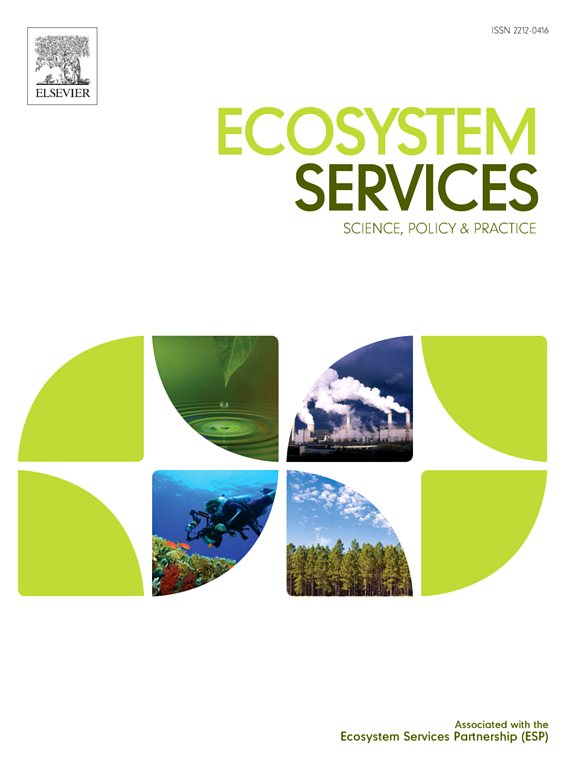Prioritising investment in kelp forest restoration: A spatially explicit benefit-cost analysis in southern Australia
IF 6.1
2区 环境科学与生态学
Q1 ECOLOGY
引用次数: 0
Abstract
Kelp forests are globally significant ecosystems providing critical ecosystem services, including fish production, nutrient cycling, carbon sequestration, and recreational uses. However, widespread degradation caused by anthropogenic pressures has led to significant declines in kelp forests, necessitating cost-effective restoration strategies. This study performs a spatially explicit benefit-cost analysis of kelp forest restoration in southern Australia to explore how variations in costs and benefits can inform prioritisation of restoration strategies. Costs of ecosystem restoration were calculated based on the time to cull overabundant sea urchins from each location and for active kelp restoration costs. We found that investing in kelp forest restoration at the broad-scale (3,291 ha) returns a positive benefit-cost ratio of 1.10 (where 1.0 is break-even). There was substantial site-specific variation in the benefit-cost ratio (0.33 to 3.4), driven by variation in predicted kelp biomass and thus nitrogen storage benefits ($0 − $105,000 /ha). For culling costs, this varied based on urchin density, the depth (dive time) and travel time to the site. Given this variation, we considered another scenario where only the reefs that returned a positive benefit-cost ration were restored (1,221 ha), which would deliver $92.1 million in benefits, from an investment of $43.9 million and would result in a benefit-cost ratio of 2.10. This research demonstrates how spatial prioritisation can guide investments in marine ecosystem restoration to maximise return on investment. However, while kelp restoration proves beneficial, realising its potential will require robust funding mechanisms (perhaps via market-based incentives), which are currently lacking.

优先投资海带林恢复:南澳大利亚的空间显性效益-成本分析
海带林是全球重要的生态系统,提供重要的生态系统服务,包括鱼类生产、养分循环、碳封存和娱乐用途。然而,人为压力造成的广泛退化已导致海带林大幅减少,因此需要具有成本效益的恢复战略。本研究对南澳大利亚海带森林恢复进行了空间明确的效益-成本分析,以探索成本和效益的变化如何为恢复策略的优先级提供信息。生态系统恢复的成本是根据从每个地点剔除过剩海胆的时间和主动海带恢复的成本来计算的。我们发现,在大范围(3291公顷)投资海带林恢复的正收益成本比为1.10(其中1.0为收支平衡)。由于预测海带生物量的变化和氮储存效益(0 - 105,000美元/公顷)的变化,效益-成本比(0.33至3.4)在不同地点有很大的差异。对于扑杀成本,这取决于海胆密度、深度(潜水时间)和到达地点的旅行时间。考虑到这种变化,我们考虑了另一种情况,即只有回报为正的效益-成本比率的珊瑚礁被恢复(1,221公顷),这将从4390万美元的投资中获得9210万美元的效益,并将导致效益-成本比为2.10。该研究展示了空间优先排序如何指导海洋生态系统恢复投资,以实现投资回报最大化。然而,尽管海带恢复被证明是有益的,但实现其潜力将需要强有力的资助机制(可能是通过基于市场的激励机制),而这正是目前所缺乏的。
本文章由计算机程序翻译,如有差异,请以英文原文为准。
求助全文
约1分钟内获得全文
求助全文
来源期刊

Ecosystem Services
ECOLOGYENVIRONMENTAL SCIENCES&-ENVIRONMENTAL SCIENCES
CiteScore
14.90
自引率
7.90%
发文量
109
期刊介绍:
Ecosystem Services is an international, interdisciplinary journal that is associated with the Ecosystem Services Partnership (ESP). The journal is dedicated to exploring the science, policy, and practice related to ecosystem services, which are the various ways in which ecosystems contribute to human well-being, both directly and indirectly.
Ecosystem Services contributes to the broader goal of ensuring that the benefits of ecosystems are recognized, valued, and sustainably managed for the well-being of current and future generations. The journal serves as a platform for scholars, practitioners, policymakers, and other stakeholders to share their findings and insights, fostering collaboration and innovation in the field of ecosystem services.
 求助内容:
求助内容: 应助结果提醒方式:
应助结果提醒方式:


